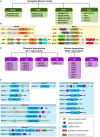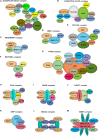The Role of Histone Protein Acetylation in Regulating Endothelial Function
- PMID: 33996829
- PMCID: PMC8113824
- DOI: 10.3389/fcell.2021.672447
The Role of Histone Protein Acetylation in Regulating Endothelial Function
Abstract
Endothelial cell (EC), consisting of the innermost cellular layer of all types of vessels, is not only a barrier composer but also performing multiple functions in physiological processes. It actively controls the vascular tone and the extravasation of water, solutes, and macromolecules; modulates circulating immune cells as well as platelet and leukocyte recruitment/adhesion and activation. In addition, EC also tightly keeps coagulation/fibrinolysis balance and plays a major role in angiogenesis. Therefore, endothelial dysfunction contributes to the pathogenesis of many diseases. Growing pieces of evidence suggest that histone protein acetylation, an epigenetic mark, is altered in ECs under different conditions, and the acetylation status change at different lysine sites on histone protein plays a key role in endothelial dysfunction and involved in hyperglycemia, hypertension, inflammatory disease, cancer and so on. In this review, we highlight the importance of histone acetylation in regulating endothelial functions and discuss the roles of histone acetylation across the transcriptional unit of protein-coding genes in ECs under different disease-related pathophysiological processes. Since histone acetylation changes are conserved and reversible, the knowledge of histone acetylation in endothelial function regulation could provide insights to develop epigenetic interventions in preventing or treating endothelial dysfunction-related diseases.
Keywords: acetyltransferase; deacetylase; endothelial dysfunction; epigenetic regulation; histone acetylation.
Copyright © 2021 Fang, Wang, Sun, Hu and Miao.
Conflict of interest statement
The authors declare that the research was conducted in the absence of any commercial or financial relationships that could be construed as a potential conflict of interest.
Figures




Similar articles
-
Histone acetyltransferase 7 (KAT7)-dependent intragenic histone acetylation regulates endothelial cell gene regulation.J Biol Chem. 2018 Mar 23;293(12):4381-4402. doi: 10.1074/jbc.RA117.001383. Epub 2018 Feb 6. J Biol Chem. 2018. PMID: 29414790 Free PMC article.
-
Normal shear stress and vascular smooth muscle cells modulate migration of endothelial cells through histone deacetylase 6 activation and tubulin acetylation.Ann Biomed Eng. 2010 Mar;38(3):729-37. doi: 10.1007/s10439-009-9896-6. Ann Biomed Eng. 2010. PMID: 20069369
-
Histone acetylation regulates the cell-specific and interferon-γ-inducible expression of extracellular superoxide dismutase in human pulmonary arteries.Am J Respir Cell Mol Biol. 2011 Nov;45(5):953-61. doi: 10.1165/rcmb.2011-0012OC. Epub 2011 Apr 14. Am J Respir Cell Mol Biol. 2011. PMID: 21493784 Free PMC article.
-
Histone Acetylation Modifiers in the Pathogenesis of Alzheimer's Disease.Front Cell Neurosci. 2015 Jun 16;9:226. doi: 10.3389/fncel.2015.00226. eCollection 2015. Front Cell Neurosci. 2015. PMID: 26136662 Free PMC article. Review.
-
Vascular Endothelial Cell Biology: An Update.Int J Mol Sci. 2019 Sep 7;20(18):4411. doi: 10.3390/ijms20184411. Int J Mol Sci. 2019. PMID: 31500313 Free PMC article. Review.
Cited by
-
Selective HDAC6 inhibition protects against blood-brain barrier dysfunction after intracerebral hemorrhage.CNS Neurosci Ther. 2024 Mar;30(3):e14429. doi: 10.1111/cns.14429. Epub 2023 Sep 4. CNS Neurosci Ther. 2024. PMID: 37665135 Free PMC article.
-
Research progress and applications of epigenetic biomarkers in cancer.Front Pharmacol. 2024 Apr 12;15:1308309. doi: 10.3389/fphar.2024.1308309. eCollection 2024. Front Pharmacol. 2024. PMID: 38681199 Free PMC article. Review.
-
Histone acetylation modulators in breast cancer.Breast Cancer Res. 2025 Mar 31;27(1):49. doi: 10.1186/s13058-025-02006-9. Breast Cancer Res. 2025. PMID: 40165290 Free PMC article. Review.
-
Histone and Histone Acetylation-Related Alterations of Gene Expression in Uninvolved Psoriatic Skin and Their Effects on Cell Proliferation, Differentiation, and Immune Responses.Int J Mol Sci. 2023 Sep 26;24(19):14551. doi: 10.3390/ijms241914551. Int J Mol Sci. 2023. PMID: 37833997 Free PMC article.
-
The Lipid Metabolism as Target and Modulator of BOLD-100 Anticancer Activity: Crosstalk with Histone Acetylation.Adv Sci (Weinh). 2023 Nov;10(32):e2301939. doi: 10.1002/advs.202301939. Epub 2023 Sep 26. Adv Sci (Weinh). 2023. PMID: 37752764 Free PMC article.
References
-
- Advani A., Huang Q., Thai K., Advani S. L., White K. E., Kelly D. J., et al. (2011). Long-term administration of the histone deacetylase inhibitor vorinostat attenuates renal injury in experimental diabetes through an endothelial nitric oxide synthase-dependent mechanism. Am. J. Pathol. 178 2205–2214. 10.1016/j.ajpath.2011.01.044 - DOI - PMC - PubMed
Publication types
Grants and funding
LinkOut - more resources
Full Text Sources
Other Literature Sources

